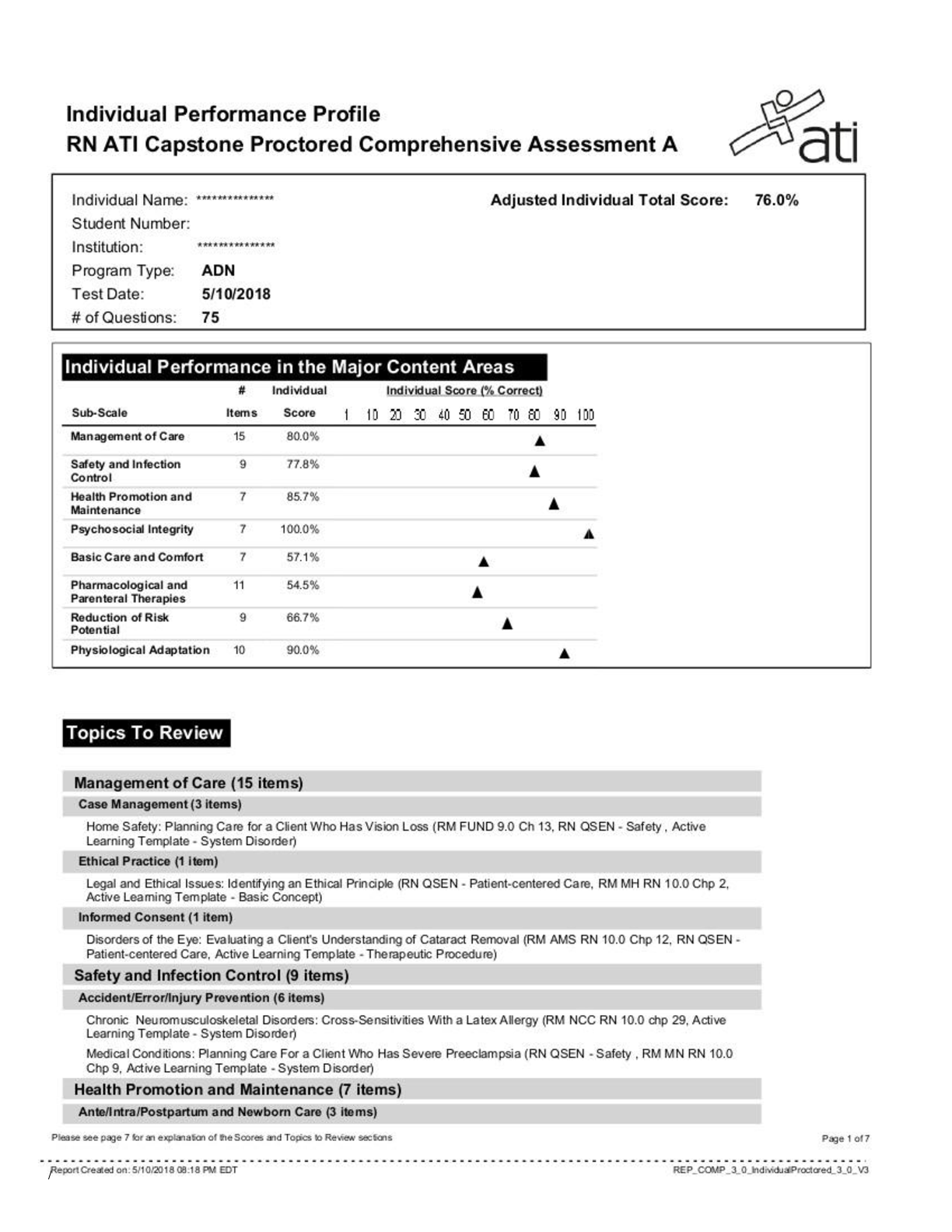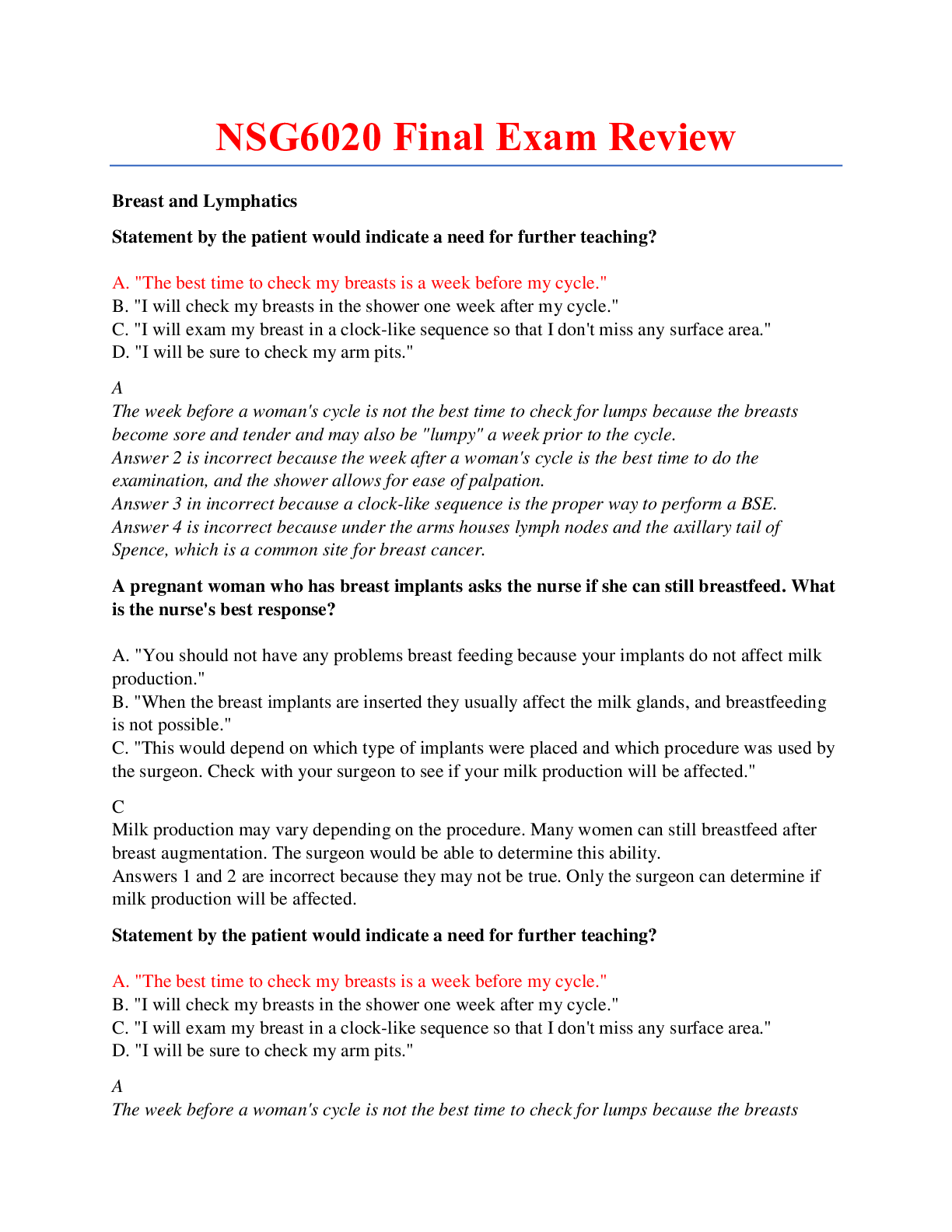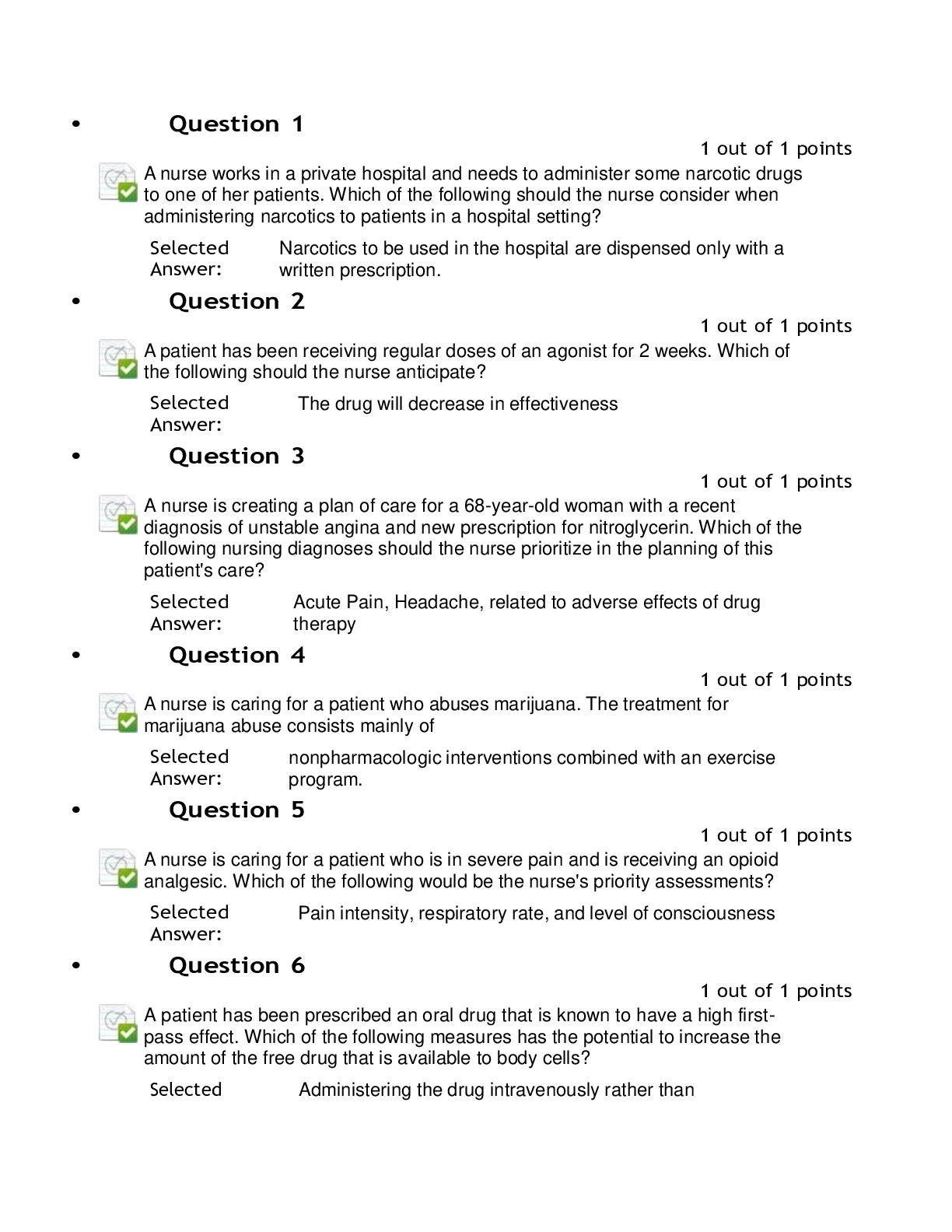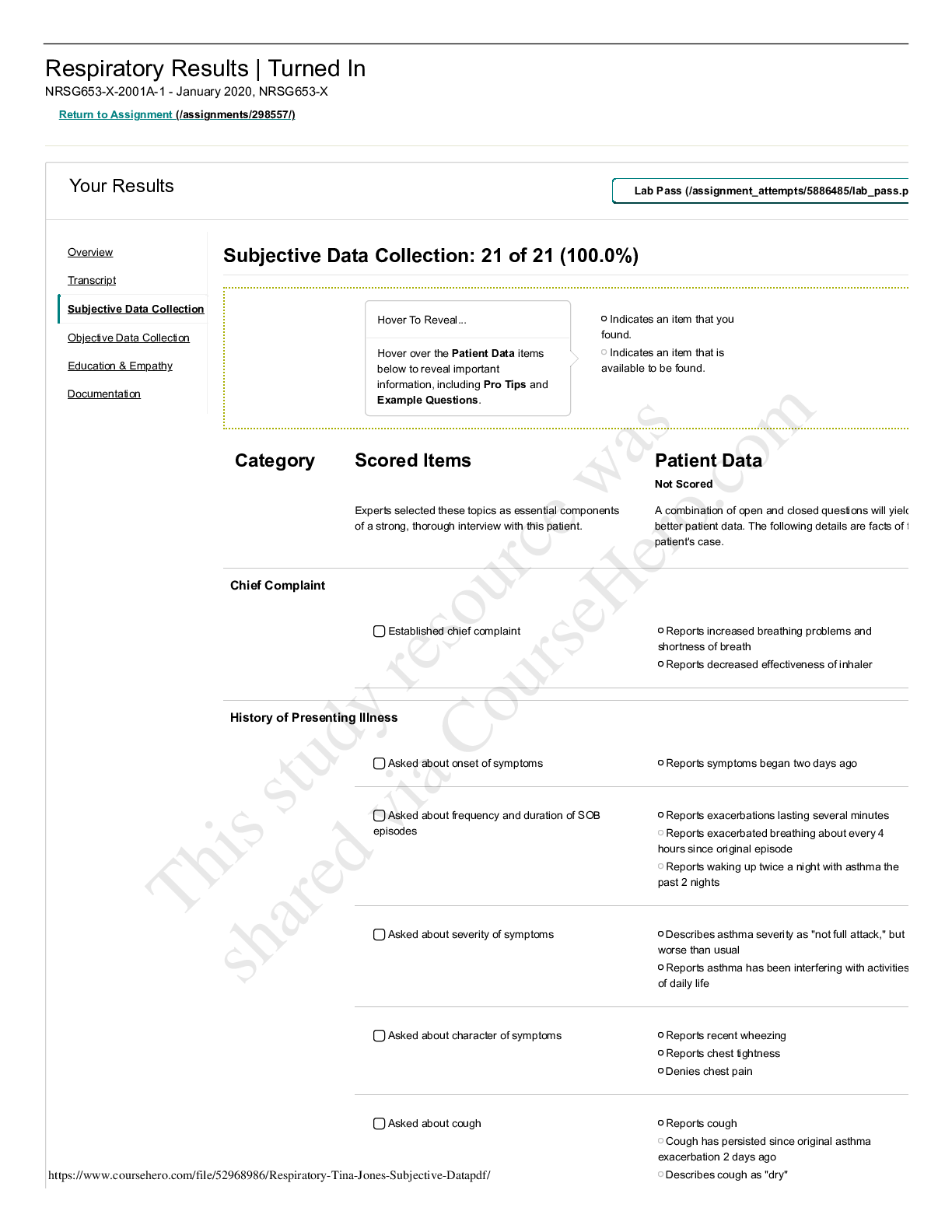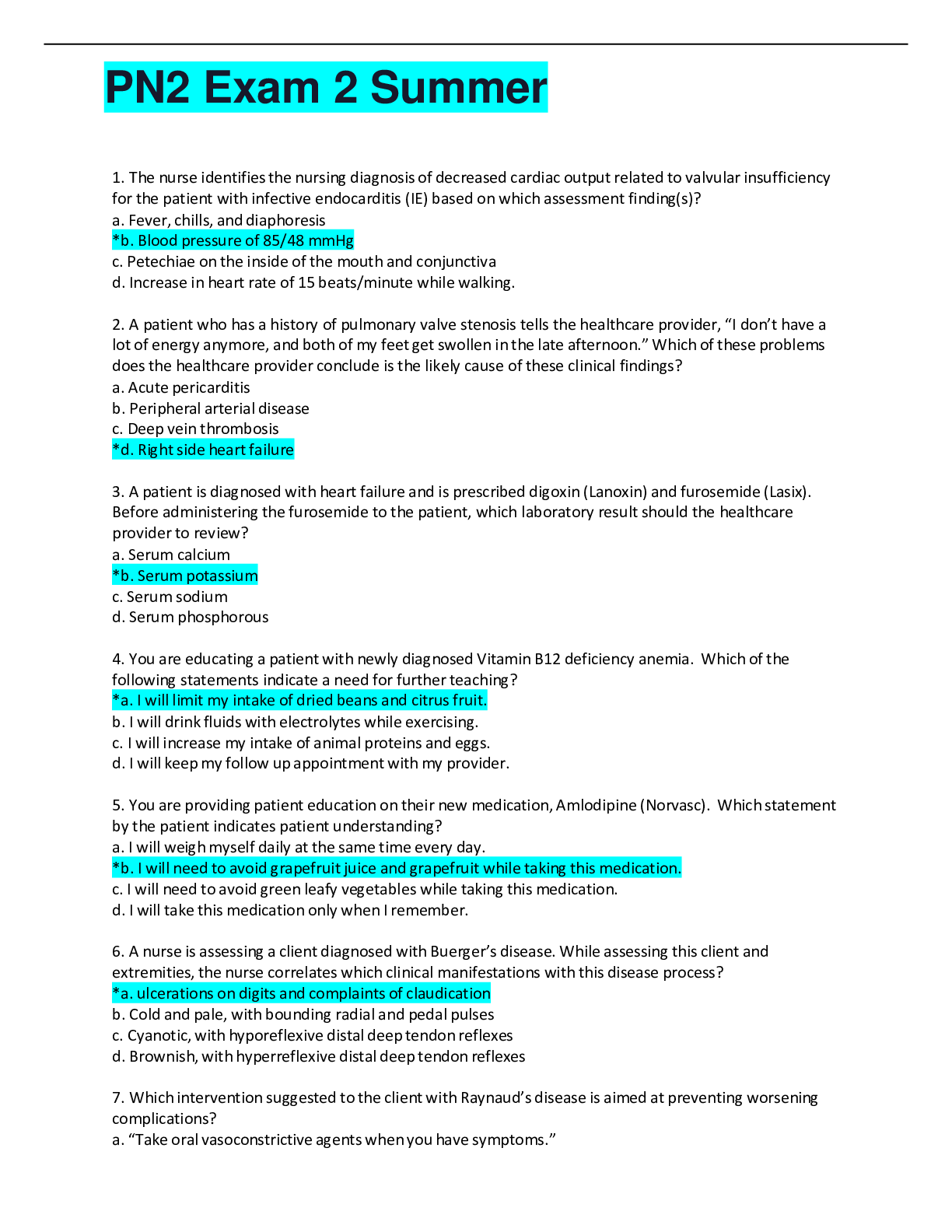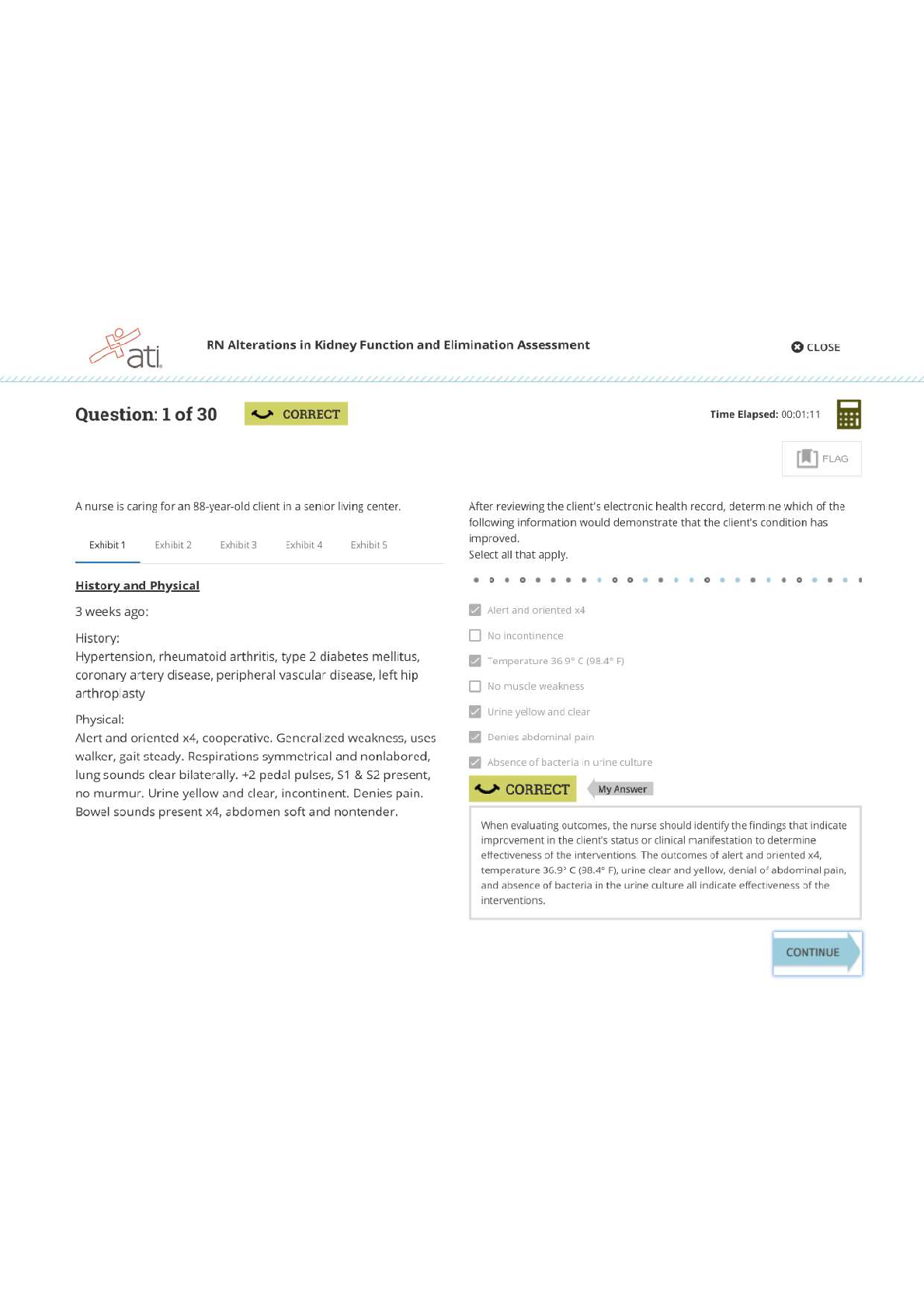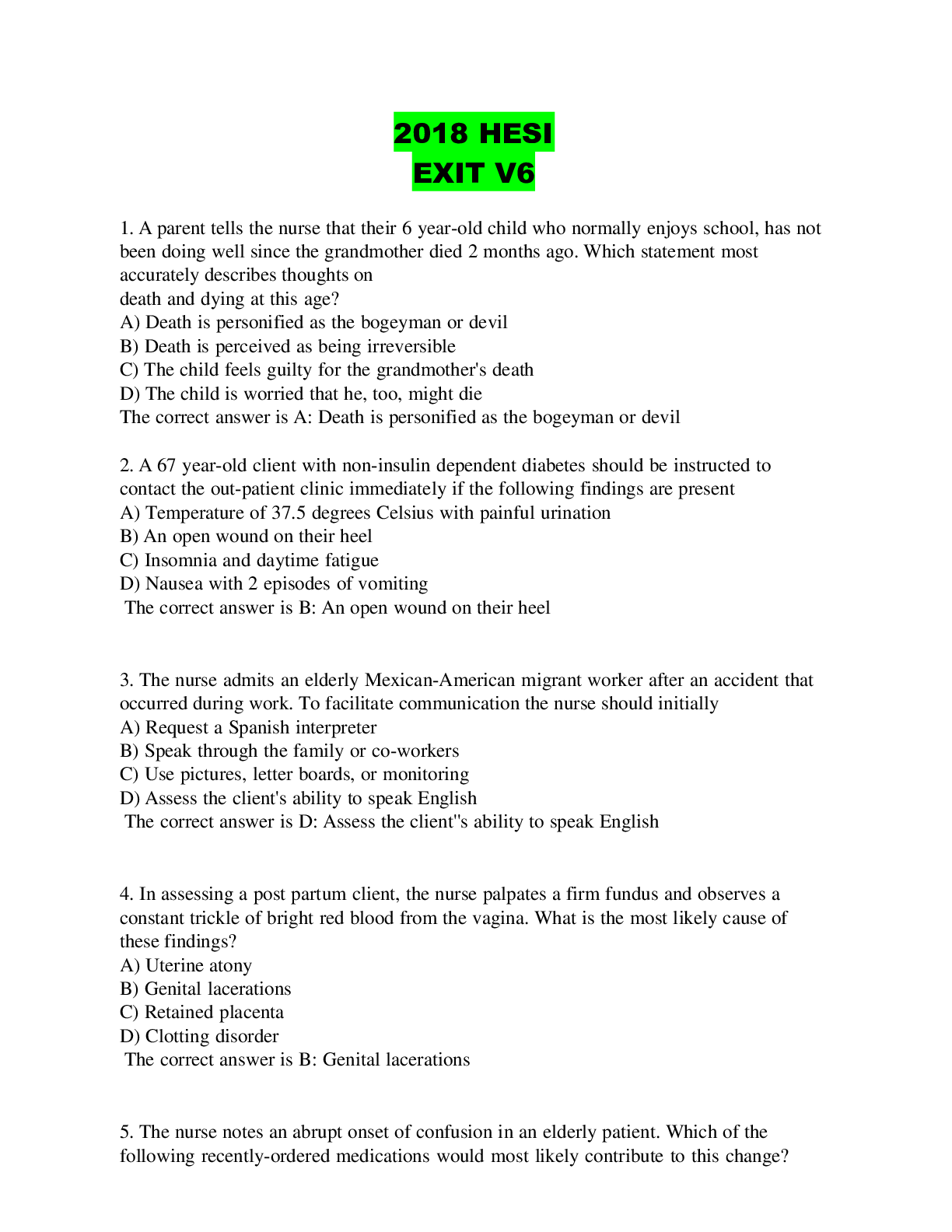Nurse Practitioner 6521. Walden University. Graded A
Document Content and Description Below
Nurse Practitioner 6521 Walden University Which patient is the most appropriate candidate for combined estrogen/progestin product for prevention of pregnancy or transition to menopause? Guideli... nes for Standard Precautions indicate that mask and eye protection or a face mask should be used while performing: A. tube feedings. B. patient bathing. C. wet-to-dry dressing changes. D. trachea care and suctioning. ANS: D Use of masks and eye protection or a face mask is indicated during procedures that are likely to generate splashes or sprays of body fluids, which include endotracheal secretions. During tube feedings, patient bathing, and wet-to-dry dressing changes, there is no splashing of body fluids. 48. You are performing a vaginal examination for a patient with a history of spina bifida. As you insert the metal speculum, the patient suddenly feels nauseated and is sweating, and her skin turns blotchy. What is your most immediate reaction to this situation? A. Replace the metal speculum with a plastic one. B. Put a blanket over the patient’s legs. C. Remove the speculum. D. Take her blood pressure. ANS: C ans C 47. When transillumination of a body cavity is performed, the use of which of the following could be harmful to the patient? A. Penlight B. Flashlight C. Halogen bulb D. Otoscope light ANS: C 46. Transillumination functions on the principle that: A. air, fluid, and tissue transmit light differentially. B. black light causes certain substances to fluoresce. C. converging and diverging light brings structures into focus. D. tangential light casts shadows that illuminate contours. ANS: A ans A 45. When monitoring serial measures, such as head circumference or abdominal girth, which procedure is best to ensure that the tape measure is placed in the same position each time? A. Record the anatomic location for tape placement in the patient’s chart. B. Mark the borders of the tape at several intervals on the skin with a pen. C. Demonstrate proper tape placement to all members of the health care team. D. Ask the same person to perform the measurement each time. 44. A variant of the percussion hammer is the neurologic hammer, which is equipped with which of the following? A. Brush and needle B. Tuning fork and cotton swab C. Penlight and goniometer D. Ruler and bell 43. To perform a deep tendon reflex measurement, you should: A. briskly tap the tendon with the rubber end of the hammer. B. place the hammer firmly on the tendon for 3 to 5 seconds. C. tap the silver end of the hammer on the tendon. D. use the needle implement to determine sensory perception. 42. Tuning forks with a frequency of 500 to 1000 Hz are most commonly used to measure: A. buzzing or tingling sensations. B. buzzing from bone conduction. C. hearing range of normal speech. D. noise above the threshold level. 41. Mr. Walters, a 32-year-old patient, tells you that his ears are “stopped up.” An objective assessment of this complaint is achieved by using the: A. tuning fork. B. reflex hammer. C. otoscope with pneumatic attachment. D. tympanometer. 40. The pneumatic attachment for the otoscope is used to evaluate: A. ear canal patency. B. eardrum landmarks. C. hearing acuity. D. tympanic membrane movement. 39. Which type of speculum should be used to examine a patient’s tympanic membrane? A. The smallest speculum that will illuminate the ear B. The largest speculum that will fit comfortably in the ear C. The shortest speculum available D. Any speculum that will fit the otoscope head A patient in the emergency department has a concussion. You suspect the patient may also have a retinal hemorrhage. You are using the ophthalmoscope to examine the retina of this patient. Which aperture of the ophthalmoscope is most appropriate for this patient? A. Grid B. Red-free filter C. Slit lamp D. Small aperture You are using an ophthalmoscope to examine a patient’s inner eye. You rotate the lens selector clockwise, then counterclockwise to compensate for: A. amblyopia. B. astigmatism. C. myopia. D. strabismus. Weak pulses, fetal heart activity, and vessel patency are all best assessed with which type of stethoscope? A. Acoustic B. Electronic C. Ultrasonic D. Magnetic A rubber or plastic ring should be around the bell end-piece of a stethoscope to: A. prevent the transmission of static electricity. B. prevent cold metal from touching the patient. C. prevent the sharp edge of the stethoscope from damaging the patient’s skin. D. ensure secure contact with the body surface. Which of the following occurs when firm pressure is used to apply the stethoscope’s bell endpiece to the skin? A. It transmits low-pitched sounds. B. It functionally converts to a diaphragm end-piece. C. Assessment findings are more accurate. D. Most sounds are occluded. The infant should be placed in which position to have his or her height or length measured? A. Vertically with the examiner’s hands under the infant’s axillae B. Supine on a measuring board C. Prone on a measuring board D. In the lateral position with the toes against a measuring board The height-measuring attachment of the standing platform scale should be pulled up: A. before the patient steps on the scale. B. before the scale is balanced. C. after the patient steps on the scale. D. only after weight has been assessed. A scale used to assess patients’ weight should be calibrated: A. only by the manufacturer. B. by a qualified technician at regularly scheduled intervals. C. each time it is used. D. when necessary, with the patient standing on the scale. 30. The fifth vital sign is: A. pain. B. orientation. C. waist-to-hip ratio. D. body mass index (BMI). 29. Tympanic thermometers measure body temperature when a probe is placed: A. anterior to the ear. B. posterior to the ear. C. under the ear. D. in the auditory canal. 28. Axillary measurement of temperature correlates best with core temperatures of: A. infants. B. adolescents. C. average-size adults. D. older adults. 27. If a sufficiently large cuff is unavailable to fit an obese arm, which technique may be used to assess blood pressure? A. Wrap a standard cuff around the deltoid area and place the stethoscope over the radial artery. B. Wrap a standard cuff around the forearm and place the stethoscope over the radial artery. C. Wrap a standard cuff around the thigh and place the stethoscope on the dorsalis pedis. D. Wrap a pediatric cuff around the ankle and place the stethoscope on the popliteal artery. 26. A blood pressure cuff bladder should be long enough to: A. cover 20% to 25% of the arm circumference. B. cover 45% to 50% of the arm circumference. C. cover 75% to 80% of the arm circumference. D. completely encircle the arm. 25. Underestimation of blood pressure will occur if the cuff’s width covers: A. less than one half of the upper arm. B. less than 5 inches of the lower arm. C. more than two thirds of the upper arm. D. more than 4 inches of the lower arm. 24. Observing the rise and fall of the abdomen usually facilitates calculation of respiratory rate in the: A. infant. B. adolescent female. C. pregnant patient. D. older adult. 23. Auscultation should be carried out last, except when examining the: A. neck area. B. heart. C. lungs. D. abdomen. 22. You are auscultating a patient’s chest. The sounds are not clear, and you are having difficulty distinguishing between respirations and heartbeats. What technique can you use to facilitate your assessment? A. Anticipate the next sounds. B. Isolate each cycle segment. C. Listen to all sounds together. D. Move the stethoscope clockwise. 21. During auscultation, you can limit your perceptual field best by: A. asking patients to describe their symptoms. B. closing your eyes. C. performing auscultation before percussion. D. using an aneroid manometer. 20. Which technique is commonly used to elicit tenderness arising from the liver, gallbladder, or kidneys? A. Finger percussion B. Palmar percussion C. Fist percussion D. Forearm percussion 19. During percussion, the downward snap of the striking fingers should originate from the: A. shoulder. B. forearm. C. wrist. D. interphalangeal joint. 18. When using mediate or indirect percussion, which technique is appropriate? A. Place the palmar surface of the nondominant hand on the body surface with the fingers held together. B. Place the palmar surface of the nondominant hand on the body surface with the fingers slightly spread apart. C. Place the ulnar surface of the nondominant hand on the body surface with the fingers together. D. Place the ulnar surface of the nondominant hand on the body surface with the fingers slightly spread apart. 17. During percussion, a dull tone is expected to be heard over: A. healthy lung tissue. B. emphysemic lungs. C. the liver. D. most of the abdomen. 16. Expected normal percussion tones include: A. dullness over the lungs. B. hyperresonance over the lungs. C. tympany over an empty stomach. D. flatness over an empty stomach. 15. The degree of percussion tone is determined by the density of the medium through which the sound waves travel. Which statement is true regarding the relationship between density of the medium and percussion tone? A. The more dense the medium, the louder is the percussion tone. B. The less dense the medium, the louder is the percussion tone. C. The more hollow the area percussed, the quieter is the percussion tone. D. Percussion over muscle areas produces the loudest percussion tones. 14. Mrs. Berger is a 39-year-old woman who presents with a complaint of epigastric abdominal pain. You have completed the inspection of the abdomen. What is your next step in the assessment process? A. Light palpation B. Deep palpation C. Percussion D. Auscultation ANS: D ANS D 13. The dorsal surface of the hand is most often used for the assessment of: A. crepitus. B. temperature. C. texture. D. vibration. 12. You are planning to palpate the abdomen of your patient. Which part of the examiner’s hand is best for palpating vibration? A. Dorsal surface B. Finger pads C. Fingertips D. Ulnar surface 11. Mrs. Smalls is a 42-year-old woman who has presented to the office for a head-to-toe examination as part of her preventive health care assessment. The room has adequate lighting, and you have access to both sides of the examining table. What position should you assume while conducting this examination? A. Behind the patient B. Either side of the patient C. Seated in a chair in front of the patient D. To the right side of the patient 10. You are caring for a nonambulatory 80-year-old male patient and he tells you, a female nurse, that he feels like he is having drainage from his rectum. Which initial nursing action is appropriate? A. Drape the patient and observe the rectal area. B. Tell the patient that his doctor will be notified of his problem. C. Tell the patient that you will ask the male nurse on the next shift to check on the problem. D. Give the patient an ice pack to apply to the area. 9. The use of secondary, tangential lighting is most helpful in the detection of: A. variations in skin color. B. enlarged tonsils. C. foreign objects in the nose or ear. D. variations in contour of the body surface. 8. Ms. Jones is a 31-year-old female patient who presents for a routine physical examination. Which examination technique will be used first? A. Light palpation B. Deep palpation C. Percussion D. Inspection 7. Which technique is used during both the history taking and the physical examination process? A. Auscultation B. Inspection C. Palpation D. Percussion 6. Mr. Walder is a 56-year-old man who has been complaining of chest palpitations. Which position is useful for auscultating heart sounds? A. Prone B. Dorsal recumbent C. Left lateral recumbent D. Right Sims 5. One recommendation to prevent latex allergy is to: A. wear latex gloves frequently to reduce sensitivity. B. use oil-based creams or lotions before donning gloves. C. wash hands with mild soap after removing gloves and then dry thoroughly. D. use well-powdered gloves with increased protein content. 4. Which patient is at the highest risk for developing latex allergy? A. The new patient who has no chronic illness and has never been hospitalized B. The patient who has had multiple procedures or surgeries C. The patient who is a vegetarian D. The patient who is allergic to contrast dye 3. According to the guidelines for Standard Precautions, the caregiver’s hands should be washed: A. only after touching body fluids with ungloved hands and between patient contacts. B. only after touching blood products with ungloved hands and after caring for infectious patients. C. only after working with patients who are thought to be infectious. D. after touching any body fluids or contaminated items, regardless of whether gloves are worn. 2. Standard Precautions apply: A. only to patients with bloodborne infections. B. only to patients with infected, draining wounds. C. only to patients believed to have an infectious disease. D. to all patients receiving care in hospitals. 1. Guidelines for Standard Precautions indicate that mask and eye protection or a face mask should be used while performing: A. tube feedings. B. patient bathing. C. wet-to-dry dressing changes. D. trachea care and suctioning. 36. Round face, preauricular fat, hyperpigmentation, and “buffalo hump” in the posterior cervical area are associated with: A. infantile hydrocephalus. B. acromegaly. C. Cushing syndrome. D. achondroplasia. 35. A prominent forehead, large nose, large jaw, and elongation of the facial bones and extremities are signs of: A. infantile hydrocephalus. B. acromegaly. C. Cushing syndrome. D. achondroplasia. 34. A pregnant woman of normal prepregnancy weight should be expected to gain how much weight per week during the second and third trimesters of pregnancy? A. 1 pound B. 1 pounds C. 2 pounds D. 2 pounds 33. Which breast Tanner stage corresponds to a secondary areola mound development above the breast? A. Stage 2 B. Stage 3 C. Stage 4 D. Stage 5 32. Which Tanner stage is marked by the most significant growth in penis length? A. Stage 1 B. Stage 2 C. Stage 3 D. Stage 4 31. What is the youngest age at which pubic hair growth in the male may be considered normal? A. 7 years B. 8 years C. 9 years D. 10 years 30. At what age does peak height growth velocity occur in boys? A. 10 years B. 12 years C. 13 years D. 15 years 29. Which of following statements regarding female pubertal changes is true? A. Most adolescent girls will develop breasts before they develop pubic hair. B. Peak height velocity should occur after menarche. C. Breast asymmetry is an abnormal finding. D. Menarche should occur by Tanner breast stage 2. 28. A Mexican American mother brings her 12-year-old daughter to the clinic because this child is not maturing as quickly as her classmates. You examine the daughter and determine that her growth and physical findings are within normal limits. You should explain to the family that: A. Mexican Americans may develop more slowly than other ethnic groups. B. more tests should be conducted because the family appears so worried. C. the daughter should drink more juices and eat more fruit. D. there is a serious problem with the daughter’s development. 27. Upper/lower segment ratio should be calculated: A. bimonthly for the first year of life. B. annually for the first 5 years. C. only when a child is suspected of having a growth problem or unusual body proportions. D. in children of first-generation immigrants. 26. Which of the following situations poses the most concern? A. The child whose weight and height ratios have remained at the 50th percentile B. The child whose weight and height ratios have stayed between the 90th and 95th percentiles C. The child whose weight and height ratios have never been above the 50th percentile D. The child whose weight and height ratios have dropped 15 percentiles from the last visit 25. In clinical practice, the Ballard Assessment Tool is used to assess a newborn’s: A. length. B. weight. C. lung maturity. D. gestational age. 24. Between 5 and 24 months of life, the infant’s chest circumference is normally: A. about equal to the head circumference. B. greater than head circumference by 2 inches. C. smaller than head circumference by about 4 inches. D. at least 2 inches smaller than head circumference. 23. To measure head circumference, the tape is wrapped snugly around the child’s head at the occipital protuberance and the: A. supraorbital prominence. B. brow line. C. nasal bridge. D. chin. 22. A marker for nutritional status is the: A. head circumference. B. waist-to-hip ratio. C. standing height. D. triceps skinfold thickness. 21. Infants born to the same parents are normally within which range of weight of each other? A. 6 ounces B. 12 ounces C. 1 pound D. 2 pounds 20. Healthy term babies generally double their birth weight by what age? A. 3 months B. 5 months C. 9 months D. 12 months 19. Which cultural group tends to have a wide variation in birth weights? A. Native Americans/American Indians B. Filipinos C. Norwegians D. Puerto Ricans 18. To estimate an individual’s frame size, the examiner should measure: A. skull circumference. B. the length from the olecranon process to the acromion process. C. elbow breadth. D. hip circumference. 17. Milestone achievements are data most likely to appear in the history of: A. adolescents. B. infants. C. school-age children. D. young adults. 16. Over the past two decades, there has been a trend toward: A. increased osteoporosis. B. preservation of height. C. obesity in older adults. D. preservation of muscle mass. 15. During a preventive health care visit, Ms. G., an older patient, states that she is getting shorter. She says that her son mentioned that her change in stature became noticeable to him during his last visit with her. Her posture appears straight and aligned. When addressing Ms. G.’s present concerns, it is most important to inquire about: A. number of pregnancies. B. parents’ heights. C. history of scoliosis. D. usual height and weight. 14. The rate of weight gain during pregnancy is expected to be: A. greatest in the first trimester. B. greatest in the second trimester. C. greatest in the third trimester. D. about the same in each trimester. 13. How much of the weight gained during a normal pregnancy is accounted for by the fetus? A. Less than 3 pounds B. 5 to 10 pounds C. 10 to 15 pounds D. 15 to 30 pounds 12. Optimal infant birth weight is difficult for pregnant adolescents to obtain because: A. they have not completed their own growth spurt. B. there are insufficient uterine supporting structures. C. the amnionic fluid is variable in pregnant adolescents. D. blood volume has not reached adult proportions. 11. Skeletal mass and organ systems double in size during: A. infancy. B. early childhood. C. adolescence. D. early adulthood. 10. The legs are the fastest growing body part during: A. early infancy. B. late infancy. C. childhood. D. early adulthood. 9. Mrs. Layton is a 33-year-old patient who has obesity. The majority of adult obesity begins: A. in adolescence. B. in childhood. C. after the skeletal growth is completed. D. once sexual maturation is complete. 8. Gender-specific skeletal differences first occur during: A. the second stage of fetal development. B. late infancy. C. early childhood. D. adolescence. 7. Fifty percent of an individual’s ideal weight is gained during: A. pregnancy. B. preschool years. C. adolescence. D. early adulthood. 6. During adolescence, the head size normally increases as a result of: A. sinus development. B. brain mass increase. C. evolution of lymphatic tissue. D. hypertrophy of myelin. 5. Mrs. Jones has brought her 24-month-old child for a well visit. Which organ(s) completes physical development more quickly than any other body part? A. Brain B. Kidneys C. Heart D. Lungs 4. By 10 to 12 years of age, lymphatic tissues are about: A. 25% of adult size. B. 50% of adult size. C. the same as adult size. D. twice the size of those in the adult. 3. After 50 years of age, stature: A. becomes fixed. B. begins a barely perceptible secondary increase. C. increases at a rate of 0.5 cm per year. D. declines. 2. Developmental changes of puberty are caused mainly by the interaction of the pituitary gland, gonads, and: A. hypothalamus. B. islet cells. C. thalamus. D. thymus. 1. The gonads begin to secrete estrogen and testosterone during: A. infancy. B. puberty. C. pregnancy. D. early adulthood. 2. The perception of pain: A. is the same across cultures. B. can be easily assessed neonates. C. is predictable with the same circumstances. D. is impacted by emotions and quality of sleep. The percepti ans d 1. The Joint Commission (TJC, formerly The Joint Commission on Accreditation of Healthcare Organizations [JCAHO]) requires that: A. pain be assessed on all discharges. B. repeated assessment of pain be limited to those patients who complain of pain. C. repeated intensity documentation be made of the course of pain relief for all patients. D. pain be assessed on surgical patients. 3. A 5-year-old is complaining of nondescriptive “belly pain.” Your next action should be to ask him to: A. point a finger to the spot that hurts. B. draw a circle around the area that hurts. C. use a metaphor to describe the pain. D. identify how pain medication affects the pain. 4. Your 85-year-old patient is complaining of right knee pain. She has a history of osteoarthritis for which she is given antiinflammatory medication. To assess her right knee pain, you should ask her if: A. the current pain is similar to previous pain. B. the left knee hurts as well. C. she took pain medication last night. D. the pain gets better when she sits. 5. Ms. Green is an 85-year-old female patient with dementia who presents to the emergency department with her daughter because of a change in function. Which pain assessment scale would be the best choice? A. Oucher Scale B. Checklist for Nonverbal Pain Indicators C. Wong/Baker Rating Scale D. CRIES Scale 6. Body language that leads you to suspect the person is in pain is: A. talkative, verbose speech. B. fretful hand movements. C. focused, fixed eye stares. D. marked salivation. 7. Mr. Green is a 68-year-old patient who has complained of pain. As the health care provider, you have decided to use a pain scale for documentation of the patient’s pain. The value of the use of scales for patients to rate their pain intensity is that: A. the emotional responses are factored in. B. correlation with others’ expectations is achieved. C. the patient’s response to therapy can be documented. D. subjective responses are eliminated. 8. You are caring for a patient with trigeminal neuralgia. During the assessment, the patient would describe the pain as: A. throbbing and dull. B. burning or shocklike. C. tender and deep. D. cramping and spasmodic. 1. When is the mental status portion of the neurologic system examination performed? A. During the history-taking process B. During assessment of cranial nerves and deep tendon reflexes C. During the time when questions related to memory are asked D. Continually, throughout the entire interaction with a patient 2. A 69-year-old truck driver presents with a sudden loss of the ability to understand spoken language. This indicates a lesion in the: A. temporal lobe. B. Broca area. C. frontal cortex. D. cerebellum. 3. Mr. DeLaurentis is a 58-year-old man who presents to your office with slumped posture and a lack of facial expression, which may indicate depression or: A. Parkinson disease. B. anxiety. C. loss of abstract reasoning. D. attention-deficit/hyperactivity disorder. 4. The ability for abstract thinking normally develops during: A. infancy. B. early childhood. C. adolescence. D. adulthood. ANS: C Abstract thinking is an intellectual maturation that develops during adolescence. ans c 5. The Mini-Mental State Examination (MMSE) may be used to: A. quantitatively estimate cognitive changes. B. qualitatively estimate personality disorders. C. diagnose neurologic disorders. D. determine the cause of memory loss. ANS: A ans a 6. Assessing orientation to person, place, and time helps determine: A. ability to understand analogies. B. abstract reasoning. C. attention span. D. state of consciousness. ANS: D ans D 7. “Arousal for short periods to visual, verbal, or painful stimuli” describes which level of consciousness? A. Lethargy B. Delirium C. Stupor D. Coma ANS: C ans c 8. When you ask the patient to tell you the meaning of a proverb or metaphor, you are assessing which of the following? A. Level of consciousness B. Abstract reasoning C. Emotional stability D. Memory ANS: B ans b 9. Impairment of arithmetic skills is often due to: A. impaired execution of motor skills. B. impaired judgment. C. perceptual distortions. D. depression. ANS: D ans d 10. Peripheral neuropathy is most likely to be manifested by: A. impaired memory. B. impaired abstract reasoning. C. impaired writing ability. D. hallucinations. ANS: C ans C 11. Recent memory may be tested by: A. asking the patient to name the past four presidents. B. asking the patient to listen to and repeat a series of numbers. C. showing the patient four items and asking him to list the items about 10 minutes later. D. asking the patient about verifiable information, such as his or her mother’s maiden name. ANS: C ans c 12. Loss of immediate and recent memory with retention of remote memory suggests: A. attention-deficit/hyperactivity disorder (ADHD). B. impaired judgment. C. stupor. D. dementia. ANS: D ans d 13. You ask the patient to follow a series of short commands to assess: A. judgment. B. attention span. C. arithmetic calculations. D. abstract reasoning. ANS: B ans b 14. Which of these observations would be most significant when assessing the condition of a patient who has judgment impairment? A. Repeated failure to complete work obligations B. Forgetting family members’ birth dates C. Going to church three times a week D. Planning for retirement in 20 years ANS: A ans a 15. Appropriateness of logic, sequence, cohesion, and relevance to topics are markers for assessment of: A. mood and feelings. B. attention span. C. thought process and content. D. abstract reasoning. ANS: C ans c 16. Which type of hallucination is most commonly associated with alcohol withdrawal? A. Olfactory B. Visual C. Auditory D. Tactile ANS: D ans dd 17. Flight of ideas or loosening of associations is associated with: A. aphasia. B. dysphonia. C. multiple sclerosis. D. psychiatric disorders. ANS: D ans d 18. Facial muscle or tongue weakness may result in: A. aphasia. B. impaired comprehension. C. neologisms. D. echolalia. ANS: A ans a 19. The Glasgow Coma Scale is used to: A. determine the cause of decreased consciousness. B. diagnose disorders that alter level of consciousness. C. quantify consciousness. D. predict response to stimulant medications. ANS: C ans c 20. The Denver II is a tool used to determine: A. a child’s IQ. B. a child’s mood. C. whether a child is educable. D. whether a child is developing as expected. ANS: D ans d 21. When the Goodenough-Harris Drawing Test is administered to a child, the evaluator principally observes the: A. presence and form of body parts. B. gender and race of the person drawn. C. approximate age and posture of the person drawn. D. length of time needed to draw a stick man. ANS: A The prese ans a 22. An older adult is administered the Set Test and scores a 14. The nurse interprets this score as indicative of: A. depression. B. cognitive impairment. C. delirium. D. dementia. ANS: D ans d 23. Which condition is considered progressive rather than reversible? A. delirium B. dementia C. depression D. anxiety ANS: B ans b 24. “A clinical syndrome of failing memory and impairment of other intellectual functions, usually related to obvious structural diseases of the brain” describes: A. delirium. B. dementia. C. depression. D. anxiety. ANS: B ans b 25. Mrs. Griffiths, a 28-year-old patient, presents to your office to discuss her attention-deficit/hyperactivity disorder (ADHD). Which statement is true in regard to ADHD? A. It occurs before 7 years of age. B. It is usually related to mental retardation. C. It is usually related to dementia. D. It is manifested by prolonged periods of catatonic behavior. ANS: A ans a 26. An aversion to touch or being held, along with delayed or absent language development, is characteristic of: A. attention-deficit/hyperactivity disorder. B. autism. C. dementia. D. mental retardation. ANS: B ans b 27. You are interviewing a 20-year-old patient with a new-onset psychotic disorder. The patient is apathetic and has disturbed thoughts and language patterns. The nurse recognizes this behavior pattern as consistent with a diagnosis of: A. depression. B. autistic disorder. C. mania. D. schizophrenia. ANS: D ans d 28. The patient who is delirious usually maintains orientation to: A. time. B. place. C. person. D. circumstance. ANS: C ans c 29. While interviewing a patient, you ask him to explain the “Lion and the Mouse” to assess: A. reading comprehension. B. attention span. C. mood and feeling. D. reasoning skills. ANS: D ans d 30. The Mini-Mental State Examination (MMSE) should be administered for the patient who: A. gets lost in her neighborhood. B. sleeps an excessive amount of time. C. has repetitive ritualistic behaviors. D. uses illegal hallucinogenic drugs. ANS: A ans a 32. George Michaels, a 22-year-old patient, tells the nurse that he is here today to “check his allergies.” He has been having “green nasal discharge” for the last 72 hours. How would the nurse document his reason for seeking care? A. G. M. is a 22-year-old male here for “allergies.” B. G. M. came into the clinic complaining of green discharge for the past 72 hours. C. M., a 22-year-old male, states he has allergies and wants them checked. D. GM. is a 22-year-old male here for having “green nasal discharge” for the past 72 hours. ANS: D Documentation of the chief complaint should always be done by using the patient’s own words in quotation marks. ans d 31. Which of the following formats would be used for visits that address problems not yet identified in the problem-oriented medical record (POMR)? A. Brief SOAP note B. Comprehensive health history C. Progress note D. Referral note ANS: A ans a 30. When recording physical findings, which data are recorded first for all systems? A. Inspection B. Percussion C. Palpation D. Auscultation ANS: A ans a 29. The examiner’s evaluation of a patient’s mental status belongs in the: A. history of present illness. B. review of systems. C. physical examination. D. patient education. ANS: C ans c 28. A SOAP note is used in which type of recording system? A. Preventive care B. Problem oriented C. Systems review D. Traditional treatment ANS: B ans b 27. Data relevant to the social history of older adults include information on: A. family support systems. B. previous health care visits. C. over-the-counter medication intake. D. date of last cancer screening. ANS: A ans a 26. Eye examination of the newborn does not routinely include assessment of: A. red reflex. B. corneal reflex. C. object tracking. D. fundus. ANS: D ans d . What finding is unique to the documentation of a physical examination of an infant? A. Fontanel sizes B. Liver span C. Prostate size D. Thyroid position ANS: A ans a 24. In which section of the newborn history would you find details of gestational assessment and extrauterine adjustment data? A. Family B. Past medical C. Personal and social D. Present problem ANS: D ans d 23. Information recorded about an infant differs from that recorded about an adult, mainly because of the infant’s: A. attention span. B. developmental status. C. nutritional differences. D. source of information. ANS: B ans b 22. Ms. G. is being seen for her routine physical examination. She is a college graduate and president of a research firm. Although her exact salary is unknown, she has adequate health insurance. Most of the above information is part of Ms. G.’s _____ history. A. family B. past medical C. personal and social D. present problem ANS: C ans c 21. Allergies to drugs and foods are generally listed in which section of the medical record? A. History of present illness B. Past medical history C. Social history D. Problem list ANS: B ans b 20. The review of systems is a component of the: A. physical examination. B. health history. C. assessment. D. past medical/surgical history. ANS: B ans b 19. The patient’s perceived disabilities and functional limitations are recorded in the: A. problem list. B. general patient information. C. social history. D. past medical history. ANS: D ans d 18. The effect of the chief complaint on the patient’s lifestyle is recorded in which section of the medical record? A. Chief complaint B. History of present illness C. Past medical history D. Social history ANS: B ans b 17. A detailed description of the symptoms related to the chief complaint is presented in the: A. history of present illness. B. differential diagnosis. C. assessment. D. general patient information section. ANS: A ans a 16. Your patient returns for a blood pressure check 2 weeks after a visit during which you performed a complete history and physical. This visit would be documented by creating a(n): A. progress note. B. accident report. C. problem-oriented medical record. D. triage note. ANS: A ans a 15. Which of the following is not a component of the plan portion of the problem-oriented medical record? A. Diagnostics ordered B. Therapeutics C. Patient education D. Differential diagnosis ANS: D ans d 14. When recording assessments during the construction of the problem-oriented medical record, the examiner should: A. combine all data into one assessment. B. create an assessment for each problem on the problem list. C. create an assessment for every abnormal physical finding. D. create an assessment for every symptom presented in the history. ANS: B ans b 13. Differential diagnoses belong in the: A. history. B. physical examination. C. assessment. D. plan. ANS: C ans c 12. A problem may be defined as anything that will require: A. evaluation. B. medication. C. surgery. D. treatment. ANS: A ans a 11. Which of the following is an example of a problem requiring recording on the patient’s problem list? A. Common age variations B. Expected findings C. Findings of unknown origin D. Minor variations ANS: C ans c 10. Drawing of stick figures is most useful to: A. compare findings in extremities. B. demonstrate radiation of pain. C. indicate consistency of lymph nodes. D. indicate mobility of masses. ANS: A ans a 9. Regardless of the origin, discharge is described by noting: A. a grading scale of 0 to 4. B. color and consistency. C. demographic data and risk factors. D. associated symptoms in alphabetic order. ANS: B ans b 8. The position on a clock, topographic notations, and anatomic landmarks: A. are methods for recording locations of findings. B. are used for noting disease progression. C. are ways for recording laboratory study results. D. should not be used in the legal record. ANS: A ans a 7. Which of the following is an effective adjunct to document location of findings during the recording of physical examinations? A. Relationship to anatomic landmarks B. Computer graphics C. Comparison with other patients of same gender and size D. Comparison to previous examinations using light pen markings ANS: A ans a 6. The quality of a symptom, such as pain, is subjective information that should be: A. deferred until the cause is determined. B. described in the history. C. placed in the past medical history section. D. placed in the history with objective data. ANS: B na sb 5. Subjective and symptomatic data are: A. documented with the physical examination findings. B. not mentioned in the legal chart. C. placed in the history section. D. recorded with the examination technique. ANS: C ans c 4. Ms. S. reports that she is concerned about her loss of appetite. During the history, you learn that her last child recently moved out of her house to go to college. Rather than infer the cause of Ms. S.’s loss of appetite, it would be better to: A. defer or omit her comments. B. have her husband call you. C. quote her concerns verbatim. D. refer her for psychiatric treatment. ANS: C ans c 3. During the course of the interview, you should: A. take no notes of any kind. B. take brief written notes. C. take detailed written notes. D. repeat pertinent comments into a Dictaphone. ANS: B ans b 2. Which part of the information contained in the patient’s record may be used in court? A. Subjective information only B. Objective information only C. Diagnostic information only D. All information ANS: D ans d 1. If information is purposefully omitted from the record, you should: A. erase the notes that are not pertinent. B. accept that sometimes data are omitted. C. state in the record why the information was omitted. D. use correction fluid to cover the information. ANS: C [Show More]
Last updated: 1 year ago
Preview 1 out of 47 pages
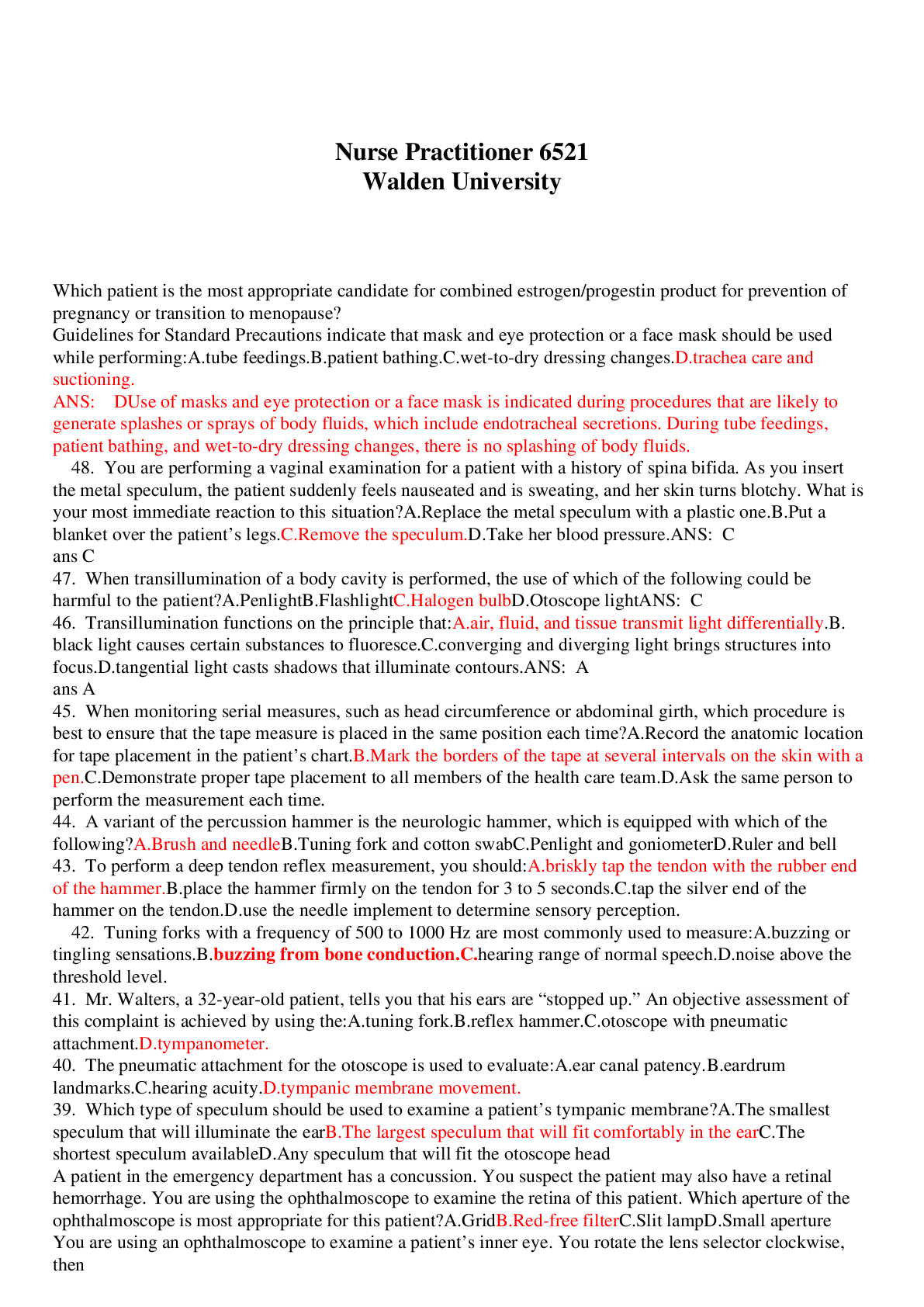
Reviews( 0 )
Document information
Connected school, study & course
About the document
Uploaded On
Aug 06, 2019
Number of pages
47
Written in
Additional information
This document has been written for:
Uploaded
Aug 06, 2019
Downloads
0
Views
160


